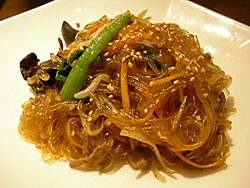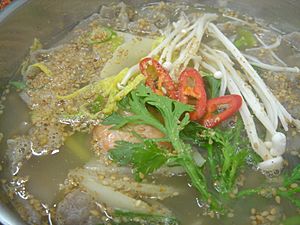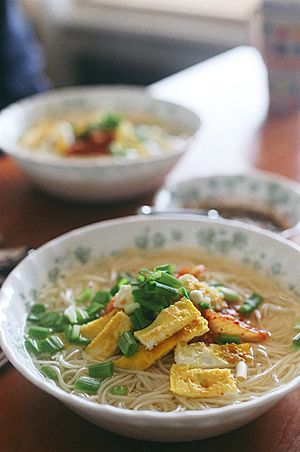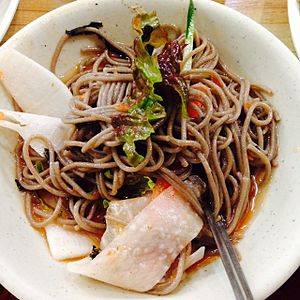Korean noodles facts for kids

Japchae, a Korean dish of stir-fried cellophane noodles
|
|
| Type | Noodle |
|---|---|
| Place of origin | Korea |
| Korean noodles | |
| Hangul |
국수 / 면
|
|---|---|
| Hanja | |
| Revised Romanization | guksu / myeon |
| McCune–Reischauer | kuksu / myŏn |
Korean noodles are a big part of Korean cuisine. People call them "guksu" in Korean or "myeon" (pronounced 'myun'). Noodles have been eaten in Asia for a very long time, even as far back as 6000 to 5000 BC!
In Korea, there are many traditional noodle dishes. Some popular ones include onmyeon (a warm noodle soup with beef broth) and naengmyeon (cold buckwheat noodles). There's also bibim guksu (cold noodles mixed with veggies and a spicy sauce) and kalguksu (noodles cut by hand). Another interesting one is kongguksu (noodles in a cold soybean broth).
Long ago, in the royal court, a special dish called baekmyeon was served. It had buckwheat noodles and a delicious pheasant broth. Naengmyeon was also enjoyed in the court during summer. It came with a cold soup made from radish kimchi and beef broth.
Contents
Different Kinds of Korean Noodles
Korean noodles are made from many different ingredients. This gives them unique tastes and textures!
- Dangmyeon (당면): These are clear noodles made from sweet potato starch. They are often used in stir-fries.
- Memil guksu (메밀국수): These noodles are made from buckwheat. They are quite similar to Japanese soba noodles.
- Gogi-guksu (고기국수): This is a noodle soup from Jeju-do island. It's made with tasty sliced pork.
- Olchaengi guksu (올챙이국수): These noodles are made from dried corn flour. People in mountainous areas like Gangwon Province enjoy them.
- Gamja guksu (감자국수): These noodles are made from a mix of potato starch, rice flour, and glutinous rice flour.
- Gamjanongma guksu (감자농마국수): Made from potato starch, these noodles are very chewy! They are a special dish from Hwanghae Province.
- Milguksu (밀국수): These are noodles made from wheat flour. Even though Koreans ate noodles long ago, wheat noodles weren't an everyday food until after 1945. This was because wheat wasn't grown as much as other crops.
- Dotori guksu (도토리 국수): These unique noodles are made from acorn flour.
- Chilk guksu (칡국수): These noodles are made from kudzu and buckwheat.
- Ssuk kalguksu (쑥칼국수): These noodles are made from Artemisia princeps (a type of mugwort) and wheat flour.
- Hobak guksu (호박국수): These noodles are made from pumpkin and wheat flour.
- Kkolttu guksu (꼴뚜국수): These noodles are made from both buckwheat and wheat flour.
- Cheonsachae (천사채): These are clear, jelly-like noodles made from kelp. They don't have grain flour or starch. They taste mild and are often used in light salads or as a garnish under raw fish. Cheonsachae are chewy and low in calories.
Delicious Noodle Dishes
Korean noodle dishes come in many forms, from warm soups to refreshing cold salads.
Warm Noodle Soups
- Japchae (잡채): This popular dish features cellophane noodles stir-fried with thin slices of beef and various vegetables. It can be served either warm or cold.
- Janchi guksu (잔치국수): These are wheat flour noodles in a light broth. The broth is often made with anchovy and sometimes kelp or beef. It's served with a special sauce of sesame oil, soy sauce, and scallions. Garnishes like fried egg strips, seaweed, and zucchini are added on top. The name janchi means "feast" or "banquet" in Korean. This dish is often eaten at birthdays, weddings, or other happy events. The long noodles symbolize a long life and a long-lasting marriage.
- Kalguksu (칼국수): These are wheat flour noodles that are cut by hand with a knife. They are served in a big bowl with a seafood-based broth and other ingredients.
- Gomguksu (곰국수): These noodles are served in a rich broth called gomguk or gomtang. This broth is made by boiling beef bones or cartilage for a long time.
- Jjamppong (짬뽕): This is a spicy noodle soup with wheat flour noodles. It includes lots of vegetables and delicious seafood.
- Jjapaguri (짜파구리): Also known as Ram-don, this dish mixes two types of instant noodles, creating a unique and popular flavor.
Cool Noodle Dishes
- Bibim guksu (비빔국수): These are thin wheat flour noodles served with a spicy sauce. The sauce is made from gochujang (Korean chili paste) and vinegar. It's often topped with half a hard-boiled egg, sliced cucumber, and sometimes chopped kimchi.
- Makguksu (막국수): This is a buckwheat noodle soup. It's very popular in Gangwon-do province and its capital city, Chuncheon.
- Naengmyeon (냉면): These are thin buckwheat noodles. They can be served in a cold soup or with a spicy gochujang-based sauce. Diners usually mix the noodles and vegetables together. It was originally a winter dish from the northern parts of Korea.
- Mul naengmyeon (물냉면): This means "water cold noodles." It comes in a bowl of tangy, cold soup. The soup is often made with beef broth or dongchimi (watery radish kimchi). You can add vinegar or mustard sauce to your liking.
- Bibim naengmyeon (비빔냉면): This means "mixed cold noodles." It's served without broth. Instead, it's mixed with a spicy, tangy sauce called chogochujang, made from gochujang, vinegar, and sugar.
- Jjolmyeon (쫄면): This dish is similar to bibim naengmyeon, but the noodles are much chewier. It's a famous dish from Incheon.
- Milmyeon (밀면): This dish is special to Busan. It's a variation of naengmyeon.
- Kongguksu (콩국수): These are wheat flour noodles served in a bowl of cold soy milk broth. It's a very refreshing dish, especially in summer.
- Jatguksu (잣국수): These noodles, made from wheat flour or buckwheat, are served in a cold broth. The broth is made from ground pine nuts and water. It's a local specialty of Gapyeong, Gyeonggi Province. It's similar to kongguksu but has a cleaner, more savory taste.
- Dongchimi guksu (동치미국수): These are wheat or buckwheat noodles served in a bowl of cold dongchimi (watery radish kimchi).
Images for kids
See also
 In Spanish: Fideos coreanos para niños
In Spanish: Fideos coreanos para niños






